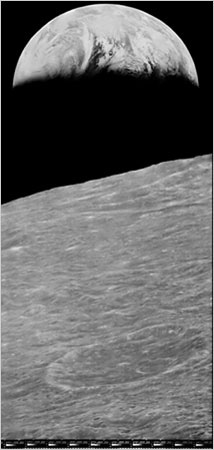
|  |  |  Editorials | Opinions | November 2008 Editorials | Opinions | November 2008  
The Moon View
 New York Times New York Times
go to original


| | Image of the Earth recovered by the Lunar Orbiter Image Recovery Project. (NASA/Lunar Orbiter Image Recovery Project) | | |
Last week, NASA released a newly restored image of a younger Earth. It was taken from Lunar Orbiter 1 in 1966, the first of several orbiters that helped gather data for the first moon landing in 1969. The photograph shows Earth just cresting the Moon’s curving horizon, the first picture of our planet framed by the surface of the Moon.

When the photograph was published, in 1966, it looked like a newsprint version of a high-contrast snapshot from space, a stark scattering of whites and blacks. The data from the lunar orbiter was stored on old analog tape drives. Now, imaging experts at NASA have digitized those drives — mining data that could not be recovered when they were first made — and produced a high-resolution version of that historic photograph.

The rough surface of the moon no longer looks starkly black and white. It has been rendered instead in a broad palette of grays, which give the moonscape a dimensional presence it never had in the photograph that first appeared. The cloud patterns that hide the surface of Earth, a crescent earth, are much more subtle.

What is most evocative is the awareness that this is our planet in 1966, which feels like a very long time ago. A train of thought immediately presents itself. If scientists can recover extensive new information from old electronic data, shouldn’t there be some way to peer beneath those clouds, back in time, and see how this planet looked when it had only half its current population?

It is probably not possible to say that one Earth is ever more innocent than another. And yet there is a feeling of innocence hanging over that beclouded planet, which was just about to get the first glimpse of itself from the Moon. |

 |
|  |



